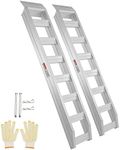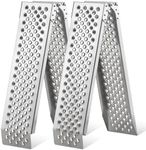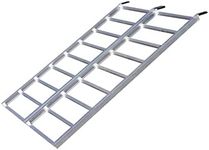Buying Guide for the Best Atv Loading Ramps
Choosing the right ATV loading ramp is important for both safety and convenience. A good ramp will make it easy to load and unload your ATV onto a truck or trailer without risking damage to your vehicle or injury to yourself. When shopping for a ramp, you should consider the type of ATV you have, how often you’ll use the ramp, and the kind of vehicle you’ll be loading onto. Understanding the key specifications will help you find a ramp that fits your needs and ensures a smooth, safe loading process.Weight CapacityWeight capacity refers to the maximum amount of weight the ramp can safely support. This is crucial because using a ramp that can't handle your ATV's weight can lead to accidents or damage. Ramps are usually divided into light-duty (up to 800 lbs), medium-duty (800-1500 lbs), and heavy-duty (over 1500 lbs). To pick the right one, check your ATV’s weight (including any gear or accessories) and choose a ramp with a capacity that exceeds this number for extra safety.
Ramp LengthRamp length determines how steep the angle will be when loading your ATV. A longer ramp creates a gentler slope, making it easier and safer to drive or push your ATV up. Ramps typically range from 6 to 12 feet. Shorter ramps are more portable but create steeper angles, which can be risky for higher truck beds. If your loading height is high or you want an easier climb, go for a longer ramp. Measure the height of your truck or trailer bed and use that to guide your choice.
Ramp WidthRamp width is the measurement across the ramp’s surface. Some ramps are single wide platforms, while others come as two separate tracks. The width should be enough to accommodate your ATV’s tires with some extra space for safety. Narrow ramps are lighter and easier to store, but wider ramps offer more stability. Check your ATV�’s tire width and make sure the ramp is wide enough for a comfortable fit.
MaterialRamps are commonly made from aluminum or steel. Aluminum ramps are lighter and easier to move around, making them great for frequent use or if you need to carry the ramp often. Steel ramps are heavier but usually more durable and can handle higher weights. If you need portability, go for aluminum; if you need maximum strength and don’t mind the extra weight, steel might be better.
Folding DesignSome ramps fold in half or even into thirds, making them easier to store and transport. Non-folding ramps are usually sturdier but take up more space. If you have limited storage or need to carry the ramp in your vehicle, a folding design is very convenient. If you’ll leave the ramp in one place, a non-folding ramp might be fine.
Traction SurfaceThe traction surface is the part of the ramp that provides grip for your ATV’s tires. Good traction is important to prevent slipping, especially in wet or muddy conditions. Ramps may have textured surfaces, raised ridges, or grip tape. If you often load in slippery conditions, look for a ramp with a strong traction surface to keep your ATV secure.
Attachment MechanismThis refers to how the ramp connects to your truck or trailer. Some ramps have hooks, straps, or rubber-coated ends to prevent slipping during use. A secure attachment is important for safety, as it keeps the ramp from moving while you load. Make sure the ramp you choose has a reliable way to attach to your loading surface, especially if you��’ll be loading alone.














